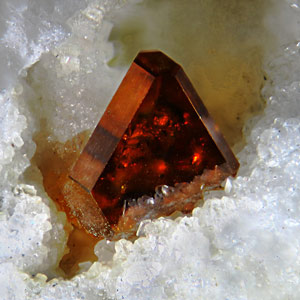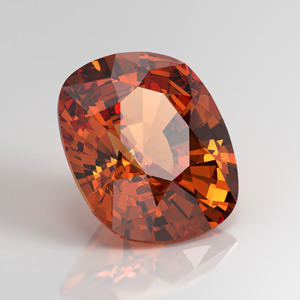sphalerite
Sphalerite, a gemstone with a name originating from the Greek word "sphaleros," meaning treacherous or deceiving, has a fascinating history and chemistry. This mineral, composed of zinc sulphide, often exhibits a range of colours, including shades of brown, yellow, green, and red.
Sphalerite's geological origins are closely tied to hydrothermal and sedimentary processes. It commonly forms in association with metallic ore deposits and is found in various locations worldwide, including the United States, Spain, and Peru.
What distinguishes sphalerite is its unique property of variable transparency. Depending on its iron content, sphalerite can be transparent, translucent, or opaque. Its exceptional dispersion, often higher than that of diamond, contributes to its fiery brilliance when properly cut and polished.
Notably, sphalerite has a complex crystal structure, leading to an interesting phenomenon called "twinning," where crystals appear to be intergrown or mirrored. This gemstone's intricate chemistry and optical properties continue to captivate mineral enthusiasts and collectors worldwide.
Click on the terms in the table below to discover their meaning



Click on the terms in the table below to discover their meaning
| Name | Sphalerite |
|---|---|
| Category | Sulphide mineral |
| Chemical Formula |
|
| IMA Symbol | Sp |
| Crystal System | Cubic (Isometric) |
| Crystal Habit | Tetrahedral, dodecahedral, typically complex and distorted, curved and conical faces common; also fibrous, botryoidal, stalactitic, cleavable, coarse to fine granular, massive |
| Twinning | Simple contact twins or complex lamellar forms |
| Cleavage | Perfect |
| Fracture | Conchoidal |
| Tenacity | Brittle |
| Hardness (Moh's Scale) |
3.5 - 4 |
| Specific Gravity | 3.9 - 4.1 |
| Diaphaneity | Transparent to translucent, opaque when iron-rich |
| Colour | Highly variable, ranging from colourless to dark brown, grey, black, commonly yellow, orange, red, green, brown |
| Streak | White or pale yellow to pale brown |
| Lustre | Adamantine to resinous |
| Optical Class | Isotropic |
| Refractive index | n = 2.369 |
| Birefringence | May show strain induced birefringence |
| Dispersion | Rd = 0.156 |
| Pleochroism | Absent |
| Clarity | Type II |
| Notable Varieties | Cleiophane, Ruby Sphalerite, Golden Sphalerite |
References
Hudson Institute of Mineralogy. (2023). Sphalerite. Retrieved from Mindat.org: https://
Mineralogical Society of America. (2005). Sphalerite. In J. W. Anthony, R. A. Bideaux, K. W. Bladh, & M. C. Nichols (Eds.), Handbook of Mineralogy. Chantilly, VA 20151-1110, USA: Mineralogical Society of America. Retrieved from https://